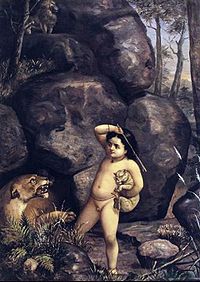- Dushyanta
-
Dushyant or Dushyanta (दुष्यन्त or दुष्यंत) was a great king in classical Indian literature and mythology. He is the husband of Shakuntala and the father of the Emperor Bharatha. He appears in the Mahabarata and in Kalidasa's play The Recognition of Sakuntala (c. 300 CE).
Contents
Historical king
According to the Mahābhārata, Dushyanta is the son of Ilina and Rathantara[1]. Dushyanta is said to have ruled, either directly or through his governors, from Gandhara (present day Kandahar in Afghanistan) to the Vindhyas and beyond, and from Sindhu, (present day Pakistan) to Vanga, (present day Bangladesh).[citation needed]
Dushyanta had by his wife Sakuntala an intelligent son named Bharata who became king. Bharata gave his name to the race of which he was the founder.
Love for Shakuntala
The story of Dushyanta's encounter, marriage, separation and reunion with his queen, Shakuntala, has been immortalized in the Mahabharata and in The Recognition of Sakuntala by the great Sanskrit poet Kalidasa.
Dushyanta meets Shakuntala, who is a daughter of Vishvamitra and Menaka, while on an excursion from his kingdom. Depending on the source,[citation needed] Dushyanta is either the crown prince, or he is waiting to win back his kingdom from an enemy. Either way, he sees Shakuntala in an ashram (hermitage) of Rishi Vasudeva Kanva and falls in love. He and Shakuntala have a gandharva marriage there. Having to leave after some time, Dushyanta gives Shakuntala a royal ring as a sign of their love, promising her that he will come to her.
But when Dushyanta becomes king, he becomes too absorbed for many years in affairs of state. Shakuntala waits and despairs.
One day, sage Durvasa visits the hermitage, but Shakuntala, who is too absorbed in her love for Dushyanta, forgets to serve him food. In a fit of anger, sage Durvasa curses her, saying that the person she is thinking about will forget her. A shocked Shakuntala begs for forgiveness and the sage, after recollecting his calm, assures her that the person will remember her again when she shows some proof of their acquaintance.
So, Shakuntala sets off to the capital, Hastinapur, to remind Dushyant of their past love. An accident occurs by which a fish consumes the royal ring, leaving Shakuntala with no formidable proof.
Dushyanta does not recollect Shakuntala, but his memory and love are rekindled when a sage (not the same who cursed Shakuntala) recovers the ring and brings it to the court. Dushyanta weds Shakuntala, who becomes his queen and mother of his son, Bharata.
A different version of the story[citation needed] involves Shakuntala's father, the great and legendary sage Vishwamithra, who is said to have bowed his head to none. Dushyanta's forgetting of Shakuntala was a device invented by the other sages, including Vashishtar, to make Vishwamithra bow. For the sake of his daughter the great sage is said to have bowed before the great king Dushyanta to persuade him to accept his daughter. The sages, delighted, immediately brought the memory of Shakuntala into the mind of Dushyanta.
Bharata
According to most mythological sources, Dushyanta was the father of Emperor Bharata, who is generally credited with uniting India under his rule (see origin of India's name). According to the Mahābhārata Adiparva, Bharata was born while Shakuntala awaited Dushyanta at her hermitage. A fisherman catches the same fish who had consumed the ring. His wife wants to make curry out of it, while cutting up the fish she finds the ring and takes it to the king. The king then remembers Shakuntala and goes to search for her.
See also
References
Hindu deities and texts Gods 
Goddesses Texts Categories:- People in Hindu mythology
- Mythological kings
- Characters in the Mahabharata
Wikimedia Foundation. 2010.

